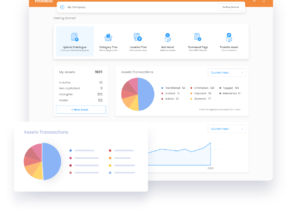What is Fixed Asset Management?
In brief, Fixed Asset Management is an accounting process that tracks fixed assets with a long asset lifecycle. Fixed Assets, while procured with large capital outlay, are not expected to convert to cash for a minimum of twelve months – they are long-term purchases. Often, fixed assets appear on a balance sheet as equipment, plant machinery and property this is sometimes abbreviated to read PP&E (or referred to as 'Capital Assets'. A good example of a company with fixed assets would be a car manufacturing company. The parts used to assemble a vehicle would not be classed as fixed assets because they are consumed quickly so therefore have limited life during the process of manufacturing. However, the large pieces of assembly machinery, the car manufacturer's factory and the land associated would all be classed as fixed assets, because they have a long-term lifecycle.

Businesses use different assets to create value. There are lots of different types of fixed assets, whether they are complex pieces of machinery or digital goods – even cash in the hand can be described as a fixed asset. However, normally, a fixed asset will have a large long-term financial and operational impact.
Fixed Asset Management is the management of those aforementioned fixed assets. The process is often used for accounting practices, preventative maintenance and deterring theft. However, without doubt, plenty of businesses find it a challenge to track the quantity, condition, fixed assets depreciation, and location of their fixed assets, as well as the maintenance.
Fixed Asset Management – The Challenges
Of course, there are challenges, for example, in manufacturing there can be data entry errors which results in the inability to track information accurately. If information has to pass through a number of different departments, this can also slow down decision-making and finally, cybersecurity is always a threat. So, as part of good Fixed Asset Management, it is very important to follow data safety and use reliable software.
Paper records and spreadsheets that are inputted using manual labor can be problematic. By the same token, many businesses use tech to manage their fixed assets but if this involves multiple pieces of software, there's the risk of error if the software doesn't 'talk' to the other software involved efficiently. It is better to have an all-in-one software solution to cope with all fixed assets in one place. This is especially important when a large business has a generous pool of fixed assets because they will generate lots of data so it must be stored using quality data management.
The right software and formulating a best practices guide helps to navigate the challenges mentioned above.
Tracking Fixed Assets
There are various methods used to track fixed assets, such as serial numbered asset tags (utilizing a barcode inventory system), QR codes and similar. Using these, the owner of any fixed assets can conduct an inventory using a mobile barcode reader (or similar) and follow that up with a report. Some fixed asset tracking methods are automated, such as using fixed scanners to read barcodes on certain products. There are other, newer technologies used for tracking fixed assets, such as fixed asset management using RFID (Radio Frequency Identification Tags).
Managing Fixed Assets
Of course, it is very important to manage fixed assets, to increase efficiency, reduce operating costs and improve profit margin. In the past, Fixed Asset Management did not utilize computers and technology. Businesses had to rely on keeping records on paper, rely on human accuracy and ensuring these records were meticulously filed away. It was a frustrating job that took time and as it was done by hand, human error was common. Nowadays, because of the significant advances of technology, there are plenty of excellent software tools available to take care of Fixed Asset Management.
The main elements involved in Fixed Asset Management are as follows:
• Recording all fixed assets, with clear asset records and an up-to-date balance sheet. This is used for financial accounting and is essential for budgeting, forecasting and making calculations for asset depreciation.
• Preventing theft, as fixed assets are expensive, theft is always a worry, and this must be monitored.
• Maintenance, again, because of the nature of fixed assets, particularly machinery and property, maintenance is vital therefore, everything must be kept in good operational order so there's less risk of mechanical failure or damage. By proactively maintaining machinery and property, for example, it reduces the risk of downtime and improves reliability.
• Regularly monitoring assets flags up issues and performance problems at the early stages, avoiding long-term failure and also improves lifespan of fixed assets.
Best Practices for Fixed Asset Management
What Are the Project Boundaries?
For new projects involving fixed assets, plan properly and keep an account of every fixed asset required, what's needed to track data, monitor performance, implement a maintenance programmer and to counteract theft.
Who is In Command?
Even using a software program to monitor fixed assets needs a commander in chief. Assigning someone to the task ensures ownership of all tasks that need tracking. It may be that a company has a team responsible for one fixed asset, a collection of fixed assets or all fixed assets (depending on the size of the company and the number of fixed assets involved).
Tagging and Tracking
One of the most important factors of good Fixed Asset Management is tracking. Every business has different fixed assets so has different tagging and tracking needs. As an example, a business with moveable fixed assets must keep a track on where they are at any given moment keeping up full visibility of their expensive asset, so needs technology that can cope with that aspect. This type of company may use Bluetooth, barcodes, QR codes and/or fixed asset GPS tracking equipment.
Dealing with Ghost Assets.
These are fixed assets that are no longer in use or no longer exist. The term for these is 'Ghost Assets.' There's no need to keep these on a business' books once they're no longer in use. By keeping them on the books, a business is liable to financial implications such as tax, insurance and more. Companies are still liable to pay for Ghost Assets if they're still tracked through accounting. Performing regular, physical audits to locate Ghost Assets helps to eliminate them and save money.
High-Performance Fixed Asset Management Software.
Implementing the right Transtek digital tools helps smooth the process. A quality system is in itself a long-term investment and therefore could also be described as a Fixed Asset, so it needs regular monitoring and auditing. A good system makes a huge difference, as it should automate most fixed management workflows, therefore reducing the number of people required to manage the assets and also decreasing the risk of human error. When selecting the right Fixed Asset Management software, base it on the business needs and the available budget. Consider the cost and how it fits with the business. It's wise to choose a provider with solid customer support and one that promises security patches and regular software updates.
Finally, for Fixed Asset Management to work to the optimum, take advantage of financial depreciation and use this to reduce business tax and insurance. Always consider the timing of purchasing new fixed assets from a financial perspective and don't be tempted to use manual spreadsheets, there will always be error which severely hampers good Fixed Asset Management.
About Transtek
Transtek Systems LLC FZ is a UAE software company, founded in 2000 and has been since supporting small, medium, enterprise corporate and governmental organizations in their digital transformation across the MENA region by solving their pain points with a wide range of innovative software solutions.
Subscribe to read the full article below.

